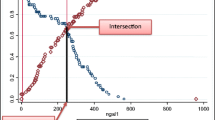Abstract
Background
Acute kidney injury (AKI) is a common cause of mortality and morbidity in asphyxiated newborns. Recent research suggests serum neutrophil gelatinase-associated lipocalin (sNGAL) as an early biomarker of AKI in newborns with perinatal asphyxia. The prospect of sNGAL is yet to be studied in Nigeria, with a huge burden of asphyxia-related neonatal deaths.
Methods
A cross-sectional analytic study was conducted on 53 asphyxiated term newborns and 53 healthy babies at the newborn unit of the Wesley Guild Hospital Ilesa, Nigeria. sNGAL was assessed in all neonates with perinatal asphyxia at baseline (within 30 min of delivery), 2 h, and 48 h of life.
Results
Mean sNGAL was significantly higher in asphyxiated newborns than in the control group, 81.4 (45.9) vs. 53.7 (29.2), p < 0.001. However, the mean 2-h sNGAL levels were similar in asphyxiated babies with and without AKI 100.5 (36.7) ng/ml vs. 85.3 (31.4) ng/ml, p = 0.115. The 2-h sNGAL with an AUC of 0.61 at an 83.0 ng/ml cut-off had an acceptable discriminating capability of predicting AKI. The sensitivity, specificity, positive predictive value, and negative predictive value were 80%, 51.5%, 50%, and 81%, respectively.
Conclusion
This study shows that sNGAL levels were significantly elevated in newborns with perinatal asphyxia compared to healthy neonates, but the 2-h sNGAL is less predictive of AKI in newborns with perinatal asphyxia. The negative predictive value is high, and this may find some relevance in the attempts at early exclusion of asphyxiated babies prone to AKI.
Graphical abstract

A higher resolution version of the Graphical abstract is available as Supplementary information


Similar content being viewed by others

References
Pan C, Avner E (2011) Glomerular filtration. In: Kliegman RM, Berman RE, Jenson HB, Schor NF, Stanton BF (eds) Nelson textbook of pediatrics, 19th edn. Saunders Elsevier, Philadelphia, p 1778
Olowu WA, Olomu S, Torimiro S, Bako A (1996) Risk factors for mortality in birth asphyxia. Niger Med Pract 31:69–73
Yu B, Li S, Yao Y, Lin Z (2009) Changes in b1 integrin in kidney tubular epithelial cells after intrauterine asphyxia of rabbit pups. J Perinat Med 37:59–65
(2001) National neonatal-perinatal database. National neonatal forum (India): report for the year 2000. www.worldcat.org. Accessed July 2014
Lu Y (1991) Correlation between neonatal Apgar scores and the results of maternal and umbilical cord blood gas analysis. Zhonghua Fu Chan Ke Za Zhi 26:205–208
Kasiulevicius V, Sapoka V, Filipaviciute R (2006) Sample size calculation in epidemiological studies. Gerontologija 7:225–231
Schmidt-Ott KM (2011) Neutrophil gelatinase-associated lipocalin as a biomarker of acute kidney injury— where do we stand today? Nephrol Dial Transplant 26:762–764
Oyedeji GA (1985) Socioeconomic and cultural background of hospitalized children in Ilesha. Niger J Paediatr 13:111–118
Levene M (1995) The asphyxiated newborn infant. In: Levene MI, Lilford RJ (eds) Fetal and neonatal neurology and neuro-surgery. Churchill Livingstone, Edinburgh, pp 405–426
Kidney disease: improving global outcomes (KDIGO) acute kidney injury work group (2012) KDIGO clinical practice guideline for acute kidney injury. Kidney Int Suppl 2:1–138
Selewski D, Charlton J, Jetton J, Guillet R, Mhanna M, Askenazi D et al (2015) Neonatal acute kidney injury. Pediatrics 136:463–473
American Society of Nephrology (2005) American Society of Nephrology renal research report. J Am Soc Nephrol 16:1886–1903
Habibzadeh F, Habibzadeh P, Yadollahie M (2016) Lessons in biostatistics on determining the most appropriate test cut-off value: the case of tests with continuous result. Biochemia Medica 26:297–307
El Raggal NM, Khafagy SM, Mahmoud NH, El Beltagy SA (2013) Serum neutrophil gelatinase-associated lipocalin as a marker of acute kidney injury in asphyxiated neonates. Indian Pediatr 50:459–462
Chandrashekar C, Venkatkrishnan A (2016) Clinical utility of serum neutrophil gelatinase associated lipocalin (NGAL) as an early marker of acute kidney injury in asphyxiated neonates. J Nepal Paediatr 36:121–125
Baumert M, Surmiak P, Więcek A, Walencka Z (2017) Serum NGAL and copeptin levels as predictors of acute kidney injury in asphyxiated neonates. Clin Exp Nephrol 21:658–664
Abdelhady S, Gawad EA, Haie OA, Mansour A (2016) Usefulness of serum and urinary neutrophil gelatinase-associated lipocalin in detecting acute kidney injury in asphyxiated neonates. Int J Med Health Sci 5:230–236
Yang S, Berdine G (2017) The receiver operating characteristic (ROC) curve. SW Resp Crit Care Chron 5:34–36
Krawczeski C, Woo J, Wang Y, Bennett M, Ma Q, Devarajan P (2011) Neutrophil gelatinase-associated lipocalin concentrations predict development of acute kidney injury in neonates and children after cardiopulmonary bypass. J Pediatr 158:1009–1015
Author information
Authors and Affiliations
Corresponding author
Ethics declarations
Competing interests
The authors declare no competing interests.
Additional information
Publisher's note
Springer Nature remains neutral with regard to jurisdictional claims in published maps and institutional affiliations.
Supplementary Information
Below is the link to the electronic supplementary material.
Rights and permissions
Springer Nature or its licensor (e.g. a society or other partner) holds exclusive rights to this article under a publishing agreement with the author(s) or other rightsholder(s); author self-archiving of the accepted manuscript version of this article is solely governed by the terms of such publishing agreement and applicable law.
About this article
Cite this article
Oso, B.I., Oseni, S.B.A., Aladekomo, T.A. et al. Predictive ability of 2-h serum neutrophil gelatinase-associated lipocalin for perinatal asphyxia-induced acute kidney injury. Pediatr Nephrol 39, 283–289 (2024). https://doi.org/10.1007/s00467-023-06054-1
Received:
Revised:
Accepted:
Published:
Issue Date:
DOI: https://doi.org/10.1007/s00467-023-06054-1



